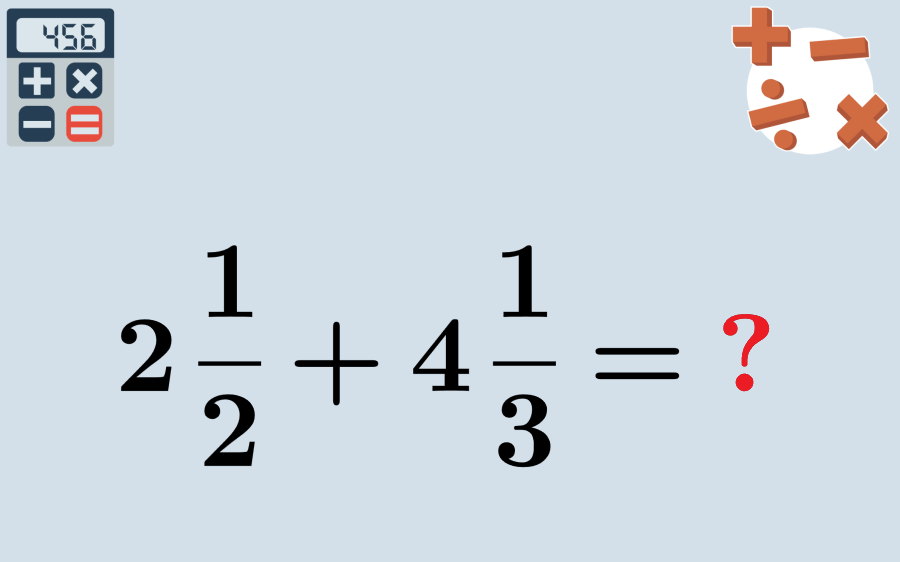Fractions that have whole numbers, also called mixed fractions, can be added following a process similar to adding normal fractions with one additional step. First, we need to convert the mixed fractions to improper fractions. Then, depending on whether the fractions are like fractions or unlike fractions, we will use a different process.
Here, we will learn to add like, and unlike mixed fractions. In addition, we will solve some practice problems to apply these concepts.
Steps to add mixed fractions
Mixed fractions are characterized by having whole numbers. If the denominators of the fractions are the same, we have like fractions and if the denominators are different, we have unlike fractions.
To add mixed fractions, we can follow the steps below.
Step 1: Convert mixed fractions to improper fractions. For this, we multiply the whole number by the denominator of the fraction and add the result to the numerator.
Step 2: Determine if the fractions are like or unlike fractions. When we have like fractions, we can skip the next steps and continue to step 6.
Step 3: When we have unlike fractions, we have to find the least common denominator (LCD) of the fractions.
Step 4: Divide the LCD by the denominator of each fraction.
Step 5: Multiply both the numerator and the denominator by the result of step 2. With this, we will obtain like fractions, where the denominator is the LCD.
Step 6: Add the like fractions. For this, we use a single denominator and add the numerators.
Step 7: Simplify the final fraction if possible.
Adding mixed fractions – Examples with answers
The following examples are solved by applying what has been learned about the addition of mixed fractions. Try to solve the problems yourself before looking at the solution.
EXAMPLE 1
Solve the addition $latex 1\frac{1}{2}+\frac{1}{2}$.
Solution
Step 1: Converting the mixed fractions to improper fractions, we have:
$$1\frac{1}{2}+\frac{1}{2}$$
$$=\frac{3}{2}+\frac{1}{2}$$
Step 2: Both denominators are equal to 2, so we have like fractions. Therefore, we continue to step 6.
Steps 3-5: Not applicable.
Step 6: To add the like fractions, we combine the denominators and add the numerators:
$$=\frac{3}{2}+\frac{1}{2}$$
$$=\frac{3+1}{2}$$
$$=\frac{4}{2}$$
Step 7: Simplifying, we have:
$$=2$$
EXAMPLE 2
Find the result to the addition $latex 2\frac{2}{3}+1\frac{1}{3}$.
Solution
Step 1: Let’s convert the mixed fractions to improper fractions:
$$2\frac{2}{3}+1\frac{1}{3}$$
$$=\frac{8}{3}+\frac{4}{3}$$
Step 2: We have like fractions since both denominators are equal to 3. Therefore, we continue to step 6.
Steps 3-5: Not applicable.
Step 6: We add the like fractions by combining the denominators and adding the numerators:
$$=\frac{8}{3}+\frac{4}{3}$$
$$=\frac{8+4}{3}$$
$$=\frac{12}{3}$$
Step 7: We can simplify the fraction:
$$=4$$
EXAMPLE 3
Solve the addition of fractions $latex 1\frac{2}{3}+\frac{1}{5}$.
Solution
Step 1: Converting the mixed fractions to improper fractions, we have:
$$1\frac{2}{3}+\frac{1}{5}$$
$$=\frac{5}{3}+\frac{1}{5}$$
Step 2: In this case, we have unlike fractions because the denominators are different. Therefore, we continue to step 3.
Step 3: The least common denominator of 3 and 5 is 15.
Step 4: Dividing 15 by 3 (first denominator), we get 5. Dividing 15 by 5 (second denominator), we get 3.
Step 5: We multiply the numerator and denominator by the numbers obtained in step 4, 5 for the first fraction, and 3 for the second:
$$=\frac{5\times 5}{3\times 5}+\frac{1\times 3}{5\times 3}$$
$$=\frac{25}{15}+\frac{3}{15}$$
Step 6: We add the like fractions by combining the denominators and adding the numerators:
$$=\frac{25}{15}+\frac{3}{15}$$
$$=\frac{25+3}{15}$$
$$=\frac{28}{15}$$
Step 7: We can simplify by writing as a mixed number:
$$=1 \frac{13}{15}$$
EXAMPLE 4
Solve the addition of mixed fractions $latex 2\frac{3}{4}+3\frac{1}{2}$.
Solution
Step 1: Converting the mixed fractions to improper fractions, we have:
$$2\frac{3}{4}+4\frac{1}{2}$$
$$=\frac{11}{4}+\frac{9}{2}$$
Step 2: We have unlike fractions because the denominators are different, so we continue to step 3.
Step 3: The least common denominator of 4 and 2 is 4.
Step 4: Dividing 4 by 4 (first denominator), we get 1. Dividing 4 by 2 (second denominator), we get 2.
Step 5: By multiplying the numerator and denominator by the numbers obtained in step 4, we have:
$$=\frac{11\times 1}{4\times 1}+\frac{9\times 2}{2\times 2}$$
$$=\frac{11}{4}+\frac{18}{4}$$
Step 6: Adding the like fractions, we have:
$$=\frac{11+18}{4}$$
$$=\frac{29}{4}$$
Step 7: We can simplify by writing as a mixed number:
$$=7 \frac{1}{4}$$
EXAMPLE 5
Solve the addition of mixed fractions $latex 1\frac{2}{5}+\frac{3}{5}+3\frac{1}{5}$.
Solution
Step 1: Converting the mixed fractions to improper fractions, we have:
$$1\frac{2}{5}+\frac{3}{5}+3\frac{1}{5}$$
$$=\frac{7}{5}+\frac{3}{5}+\frac{16}{5}$$
Step 2: Here, we have like fractions, so we continue to step 6.
Steps 3-5: Not applicable.
Step 6: Combining the denominators and adding the numerators, we have:
$$=\frac{7}{5}+\frac{3}{5}+\frac{16}{5}$$
$$=\frac{7+3+16}{5}$$
$$=\frac{26}{5}$$
Step 7: We can simplify the fraction by converting it to a mixed fraction:
$$=5\frac{1}{5}$$
EXAMPLE 6
Solve the addition of mixed fractions $latex 2\frac{3}{4}+1\frac{2}{3}+1\frac{4}{5}$.
Solution
Step 1: Converting the mixed fractions to improper fractions, we have:
$$2\frac{3}{4}+1\frac{2}{3}+1\frac{4}{5}$$
$$=\frac{11}{4}+\frac{5}{3}+\frac{9}{5}$$
Step 2: We have three unlike fractions, so we continue to step 3.
Step 3: The least common denominator of 4, 3, and 5 is 60.
Step 4: Dividing 60 by 4 (first denominator), we get 15. Dividing 60 by 3 (second denominator), we get 20. Dividing 60 by 5 (third denominator), we get 12.
Step 5: We multiply the numerators and denominators of the fractions by the numbers obtained in step 4, we have:
$$=\frac{11\times 15}{4\times 15}+\frac{5\times 20}{3\times 20}+\frac{9\times 12}{5\times 12}$$
$$=\frac{165}{60}+\frac{100}{60}+\frac{108}{60}$$
Step 6: Adding the like fractions, we have:
$$=\frac{165+100+108}{60}$$
$$=\frac{373}{60}$$
Step 7: We can simplify by writing as a mixed number:
$$=6 \frac{13}{60}$$
Addition of mixed fractions – Practice problems
Solve the following additions of mixed fractions. If you have trouble with these problems, you can use the solved examples above as a guide.
See also
Interested in learning more about adding fractions? You can take a look at these pages:




